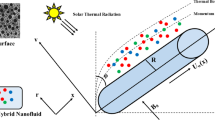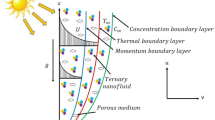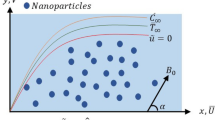Abstract
The use of nanofluid in thermal applications dramatically enhanced the pattern of heat and mass transmission, which is essential in numerous engineering and industrial areas. Numerous innovative applications in solar energy and thermal engineering can be attributed to the consideration of nanofluid. Additionally, motile microorganisms, which have applications in enzymes, bioengineering, biomedicine, biofuels and petroleum sciences, perfectly improve the stability of nanofluid. The study of nanofluid has several dynamic applications in renewable energy and thermodynamic engineering problems. The aim of this paper is to discuss the chemical viscous dissipative transport of Buongiorno’s nanofluid across an inclined plane, considering Brownian movement and thermophoresis effects. The governing equations and the associated boundary conditions are normalized using the non-similarity transformation approach. The key variables and corresponding non-similarity solutions are provided to summarize the transpiration parameters. The Keller’s Box method is used to obtain the mathematical solutions. The numerical findings are given for various thermos-physical parameter values both physically and quantitatively. The graphical effects of various thermos-physical factors on momentum, energy, nanoparticle volume fraction concentration, shear stress rate, heat and mass transfer rates are examined and well discussed. The results show strong associations when compared to previously published literature. A slight increase in velocity with a rise in Kr values. Whereas, a slight decrease in temperature with an increase in Kr values and a strong decrease in nanoparticle volume fraction concentration with an increase in Kr values. A significant increase in velocity and temperature is seen with an increase in Ec and Nb values while nanoparticle volume fraction concentration is seen to decrease slightly.



















Similar content being viewed by others
Data Availability
Data available within the article or its supplementary materials.
Abbreviations
- C :
-
Nanoparticle volume fraction
- C f :
-
Skin Friction Coefficient
- c p :
-
Specific heat, (J/(K kg))
- D B :
-
Brownian diffusion coefficient, (m2/s)
- Dm :
-
Mass diffusion, (m2/s)
- D T :
-
Thermophoretic diffusion coefficient (m2/s)
- Ec :
-
Eckert number
- f :
-
Dimensionless stream function
- g :
-
Gravitational acceleration, (m/s2)
- Gr x :
-
Local Grashof number
- k :
-
Thermal conductivity of the fluid, (W/(m k)
- k m :
-
Effective thermal conductivity, (W/(m k)
- K 1 :
-
First order chemical reaction rate
- Kr :
-
Chemical reaction parameter
- Nb :
-
Brownian motion parameter
- Nt :
-
Thermophoresis parameter
- Nr :
-
Buoyancy ratio parameter
- Nu :
-
Heat transfer coefficient
- Pr :
-
Prandtl number
- Ri :
-
Richardson number
- Re x :
-
Local Reynolds number
- S :
-
Cauchy stress tensor
- Sc :
-
Schmidt number
- Sh :
-
Mass transfer coefficient
- T :
-
Fluid temperature, (K)
- L :
-
Characteristic Length (m)
- V :
-
Velocity vector, (m/s)
- u, v :
-
Dimensionless velocity components in X and Y direction respectively, (m/s2)
- X :
-
Stream wise coordinate
- Y :
-
Transverse coordinate
- P :
-
Pressure (kg/m s2)
- α f :
-
Thermal diffusivity of the Nanofluid, (m2/s)
- β :
-
Volumetric volume expansion coefficient of the fluid (ppm/0F)
- τ :
-
Ratio of effective heat capacity of nanoparticle to the heat capacity of the fluid
- σ :
-
Electric conductivity of the fluid, (kg−1 m−3 s3 A2)
- η :
-
Non-dimensional radial coordinate
- μ f :
-
Dynamic viscosity, (Ns/m2)
- ξ :
-
Non-dimensional tangential coordinate
- ψ :
-
Non-dimensional stream function
- ν :
-
Kinematic viscosity, (m2/s)
- ϕ :
-
Dimensionless concentration
- θ :
-
Dimensionless temperature
- ρ p :
-
Fluid density of the nanoparticles, (kg/m3)
- ( ρ c) p :
-
Effective heat capacity of the nanoparticles, (J/m3 K)
- ρ f :
-
Density of the fluid
- Ω :
-
Inclination angle
- ( ρ c) f :
-
Effective heat capacity of the base fluid, (J/m3 K)
- W :
-
Conditions on the wall
- ∞ :
-
Free stream condition
References
Hayat, T., Ahmed, B., Abbasi, F., Alsaedi, A.: Hydromantic peristalsis of water based nanofluids with temperature dependent viscosity a comparative study. J. Mol. Liq. 234, 324–329 (2017)
S.U.S. Choi and J.A. Eastman: Enhancing thermal conductivity of fluids with nanoparticles, In: The proceedings of the 1995 ASME International Mechanical Engineering Congress and Exposition, ASME, San Francisco, USA, 1995, 99–105. FED 231/MD 66.
Buongiorno, J.: Convective transport in nanofluids. ASME J. Heat Transfer 128, 240–250 (2006)
Akhtar, R., Awais, M., Raja, M.A., Abrar, M.N., Shah, S.A., Yuan, A., Awan, S.E., Shoaib, M., Xu, L., Shaheen, A., Aslam, B.: Analytical treatment for the dynamics of second law analysis of Jeffery nanofluid with convective heat and mass conditions. J. Nanoelectron. Optoelectron. 16(1), 89–96 (2021). https://doi.org/10.1166/jno.2021.2909
Awais, M., Awan, S.E., Raja, M.A.Z., Nawaz, M., Khan, W.U., Malik, M.Y., He, Y.: Heat transfer in nanomaterial suspension (CuO and Al2O3) using KKL model. Coatings 11, 417 (2021). https://doi.org/10.3390/coatings11040417
Awais, M., Ehsan Awan, S., Asif Zahoor Raja, M., Parveen, N., Khan, W.U., Yousaf Malik, M., He, Y.: Effects of variable transport properties on heat and mass transfer in MHD bioconvective nanofluid rheology with gyrotactic microorganisms: numerical approach. Coatings 11, 231 (2021). https://doi.org/10.3390/coatings11020231
Abbas, N., Shatanawi, W., Shatnawi, T.A.M., Rehman, K.U.: Velocity and Thermal slips impact on boundary layer flow of micropolar nanofluid over a vertical nonlinear stretched Riga sheet. Proc. Inst. Mech. Eng., Part N: J. Nanomater., Nanoeng Nanosyst. (2023). https://doi.org/10.1177/23977914231156685
Abbas, N., Rehman, K.U., Shatanawi, W., Abodayeh, K.: Mathematical model of temperature-dependent flow of power-law nanofluid over a variable stretching Riga sheet. Waves Random Complex Media (2022). https://doi.org/10.1080/17455030.2022.2111029
Abbas, N., Rehman, K.U., Shatanawi, W., Malik, M.Y.: Numerical study of heat transfer in hybrid nanofluid flow over permeable nonlinear stretching curved surface with thermal slip. Int. Commun. Heat Mass Transf. 135, 106107 (2022). https://doi.org/10.1016/j.icheatmasstransfer.2022.106107
Vedavathi, N., Dharmaiah, G., Abdul Gaffar, S., Venkatadri, K.: Entropy analysis of Nanofluid magnetohydrodynamic convection flow past an inclined surface: a numerical review. Heat Transf. J. (2021). https://doi.org/10.1002/htj.22159
Vedavathi, N., Dharmaiah, G., Abdul Gaffar, S., Venkatadri, K.: Entropy analysis of magnetohydrodynamic nanofluid transport from an inverted cone: Buongiorno’s model. Heat Transf. J. (2020). https://doi.org/10.1002/htj.22021
Venkatadri, K., Abdul Gaffar, S., Ramachandra Prasad, V., Md, B., Khan, H., Anwar Beg, O.: Melting heat transfer analysis of electrically conducting nanofluid flow over an exponentially shrinking/stretching porous sheet with radiative heat flux under a magnetic field. Heat Transf. J. 49(8), 4281–4303 (2020)
Vedavathi, N., Dharmaiah, G., Venkatadri, K., Abdul Gaffar, S.: Numerical study of Radiative non-Darcy Nanofluid flow over a stretching sheet with convective nield conditions and energy activation. Nonlinear Eng 10(1), 159–176 (2021)
Abbas, N., Shatanawi, W., Abodayeh, K.: Computational analysis of MHD nonlinear radiation casson hybrid nanofluid flow at vertcial stretching sheet. Symmetry 17(7), 1494 (2022). https://doi.org/10.3390/sym14071494
Abbas, N., Shatanawi, W.: Heat and mass transfer of micropolar-casson nanofluid over vertical variable stretching Riga sheet. Energies 15(14), 4945 (2022). https://doi.org/10.3390/en15144945
Abbas, N., Shatanawi, W.: Theoretical survey of time-dependent micropolar nanofluid flow over a linear curved stretching surface. Symmetry 14(8), 1629 (2022). https://doi.org/10.3390/sym14081629
Shatnawi, T.A.M., Abbas, N., Shatanawi, W.: Comparative study of Casson hybrid nanofluid models with induced magnetic radiative flow over a vertical permeable exponentially stretching sheet. AIMS Math. 7(12), 20545–20564 (2022). https://doi.org/10.3934/math.20221126
Parveen, N., Awais, M., Awan, S.E., Shah, S.A., Aihua Yuan, M., Nawaz, R.A., Malik, M.Y.: Thermophysical properties of chemotactic microorganisms in bio-convective peristaltic rheology of nano-liquid with slippage, Joule heating and viscous dissipation. Case Stud Therm Eng 27, 101285 (2021). https://doi.org/10.1016/j.csite.2021.101285
Shoaib, M., Raja, M.A.Z., Sabir, M.T., Awais, M., Islam, S., Shah, Z., Kumam, P.: Numerical analysis of 3-D MHD hybrid nanofluid over a rotational disk in presence of thermal radiation with Joule heating and viscous dissipation effects using Lobatto IIIA technique. Alex. Eng. J. 60, 3605–3619 (2021). https://doi.org/10.1016/j.aej.2021.02.015
Awais, M., Awan, S.E., Raja, M.A.Z., Shoaib, M.: Effects of gyro-tactic organisms in bio-convective nano-material with heat immersion stratification, and viscous dissipation. Arab. J. Sci. Eng. 46, 5907–5920 (2021). https://doi.org/10.1007/s13369-020-05070-9
Mumraiz, S., Aamir Ali, M., Awais, M.S., Shah, Z.: Entropy generation in electrical magnetohydrodynamic flow of Al2O3–Cu/H2O hybrid nanofuid with non-uniform heat flux. J. Therm. Anal. Calorim. 143, 2135–2148 (2021). https://doi.org/10.1007/s10973-020-09603-0
Khan, W.U., Awais, M., Parveen, N., Ali, A., Awan, S.E., Malik, M.Y., He, Y.: Analytical assessment of (Al2O3–Ag/H2O) hybrid nanofluid influenced by induced magnetic field for second law analysis with mixed convection, viscous dissipation and heat generation. Coatings 11, 498 (2021). https://doi.org/10.3390/coatings11050498
Awan, S.E., Awais, M., Raja, M.A.Z., Parveen, N., Ali, H.M., Khan, W.U., He, Y.: Numerical treatment for dynamics of second law analysis and magnetic induction effects on ciliary induced peristaltic transport of hybrid nanomaterial. Front. Phys. 9, 631903 (2021). https://doi.org/10.3389/fphy.2021.631903
Shatnawi, T.A.M., Abbas, N., Shatanawi, W.: Mathematical analysis of unsteady stagnation point flow of radiative casson hybrid nanofluid flow over a vertical Riga sheet. Mathematics 10, 3573 (2022). https://doi.org/10.3390/math10193573
Cui, J., Razzaq, R., Farooq, U., Khan, W.A., Farooq, F.B., Muhammad, T.: Impact of non-similar modeling for forced convection analysis of nanofluid flow over stretching sheet with chemical reaction and heat generation. Alex. Eng. J. (2021). https://doi.org/10.1016/j.aej.2021.09.045
Singh, K., Pandey, A.K., Kumar, M.: Slip flow of micropolar fluid through a permeable wedge due to the effects of chemical reaction and heat source/sink with Hall and ion-slip currents: and analytic approach. Propuls. Power Res. 9(3), 289–303 (2020)
Asjad, M.I., Sarwar, N., Ali, B., Hussain, S., Sitthiwirattham, T., Reunsumrit, J.: Impact of Bioconvection and chemical reaction on MHD nanofluid flow due to exponential stretching sheet. Symmetry 13, 2334 (2021)
Lv, Y.-P., Shaheen, N., Muhammad Ramzan, M., Mursaleen, K.S., Malik, N.M.Y.: Chemical reaction and thermal radiation impact on a nanofluid flow in a rotating channel with hall current. Sci. Rep. 11, 19747 (2021)
Ramzan, M., HinaGul, D.B., Nisar, K.S., Malik, M.Y.: Role of Cattaneo-Christov heat fux in an MHD Micropolar dusty nanofuid fow with zero mass fux condition. Sci. Rep. 11, 19528 (2021)
Abbas, N., Shatanawi, W., Hasan, F., Shatnawi, T.A.M.: Numerical analysis of Darcy resistant Sutterby nanofluid flow with effect of radiation and chemical reaction over stretching cylinder: induced magnetic field. AIMS Math. 8(5), 11202–11220 (2023). https://doi.org/10.3934/math.2023567
Madhavi, K., Ramachandra Prasad, V., Abdul Gaffar, S.: Polymeric dissipative convection flow from an inclined plane with chemical reaction: numerical study. J. Appl. Comput. Mech. 8(2), 416–428 (2022)
Ramesh Reddy, P., Abdul Gaffar, S., Anwar Beg, O., Hidayathulla Khan, BMd.: Hall and ionslip effects on nanofluid transport from a vertical surface: Buongiorno’s model. ZAMM J. Appl. Math. Mech. 103(3), E202000174 (2022). https://doi.org/10.1002/zamm.202000174
Alharbi, F.M., Naeem, M., Zubair, M., Jawad, M., Jan, W.U., Jan, R.: Bioconvection due to gyrotactic microorganisms in couple stress hybrid nanofluid laminar mixed convection incompressible flow with magnetic nanoparticles and chemical reaction as carrier for targeted drug delivery through porous stretching sheet. Molecules 26, 3954 (2021)
Keller, H.B.: Numerical methods in boundary-layer theory. Ann. Rev. Fluid Mech. 10, 417–433 (1978)
Lloyd, J.R., Sparrow, E.M.: Combined forced and free convection flow on vertical surfaces. Int. J. Heat Mass Transf. 13(2), 434–438 (1970)
Kuznetsov, A.V., Nield, D.A.: Natural convective boundary layer flow of a nanofluid past a vertical plate. Int. J. Therm. Sci. 49, 243–247 (2010)
Abdul Gaffar, S., Ramachandra Prasad, V., Anwar Bég, O., Hidayathulla Khan, M., Venkatadri, K.: Radiative and magnetohydrodynamics flow of third grade viscoelastic fluid past an isothermal inverted cone in the presence of heat generation/absorption. J. Braz. Soc. Mech. Sci. Eng. 40, 127–146 (2018)
Abdul Gaffar, S., Ramachandra Prasad, V., Keshava Reddy, E., Anwar Beg, O.: Magnetohydrodynamic free convection boundary layer flow of non-Newtonian tangent hyperbolic fluid from a vertical permeable cone with variable surface temperature. J. Braz. Soc. Mech. Sci. Eng. 39, 101–116 (2017)
Abdul Gaffar, S., Ramachandra Prasad, V., Rushi Kumar, B., Anwar Beg, O.: Computational modelling and solutions for mixed convection boundary layer flows of nanofluid from a non-isothermal wedge. J. Nanofluids 7(5), 1024–1032 (2018)
Hidayathulla Khan, BMd., Abdul Gaffar, S., Anwar Beg, O., Ali Kadir, P., Reddy, R.: Computation of eyring-powell micropolar convective boundary layer flow from an inverted non-isothermal cone: thermal polymer coating simulation. Comput. Therm. Sci. 12(4), 329–344 (2020). https://doi.org/10.1615/ComputThermalScien.2020033860
Vedavathi, N., Dharmaiah, G., Abdul Gaffar, S., Venkatadri, K.: Entropy analysis of magnetohydrodynamic nanofluid transport from an inverted cone: Buongiorno’s model. Heat Transf J. 50(4), 3119–3153 (2021)
Abdul Gaffar, S., Anwar Beg, O., Ramachandra Prasad, V.: Mathematical modeling of natural convection in a third grade viscoelastic micropolar fluid from an isothermal inverted cone. Iran. J. Sci. Technol. Trans. Mech. Eng. 44, 383–402 (2020). https://doi.org/10.1007/s40997-018-0262-x
Khan, B.M., Gaffar, S.A., Bég, O.A.: Anwar Beg, entropy generation in magnetohydrodynamic radiative non-Newtonian dissipative convection flow from an inclined plane: Numerical Study. Nanosci. Technol.: Int. J. 11(4), 297–326 (2020)
Funding
The authors have not disclosed any funding.
Author information
Authors and Affiliations
Contributions
Ramesh reddy wrote the main manuscript text and Abdul Gaffar prepared figures and tables. All authors reviewed the manuscript.
Corresponding author
Ethics declarations
Competing of interest
The authors declare no competing interests.
Additional information
Publisher's Note
Springer Nature remains neutral with regard to jurisdictional claims in published maps and institutional affiliations.
Rights and permissions
Springer Nature or its licensor (e.g. a society or other partner) holds exclusive rights to this article under a publishing agreement with the author(s) or other rightsholder(s); author self-archiving of the accepted manuscript version of this article is solely governed by the terms of such publishing agreement and applicable law.
About this article
Cite this article
Reddy, R., Gaffar, S.A. Chemical Reaction and Viscous Dissipative Effects on Buongiorno’s Nanofluid Model Past an Inclined Plane: A Numerical Investigation. Int. J. Appl. Comput. Math 10, 81 (2024). https://doi.org/10.1007/s40819-024-01723-7
Accepted:
Published:
DOI: https://doi.org/10.1007/s40819-024-01723-7




